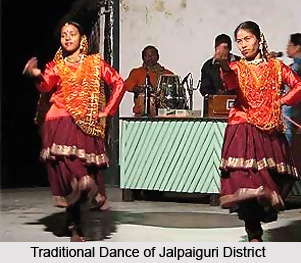 The present district of Jalpaiguri in West Bengal is the colonized settlement of several dynasties from the primeval of history. Before the formation of Jalpaiguri district as an integrated district, the fragmented part of the present region has been ruled by the various civilizations. Consequentially, when the fragmented parts are united, the integrated district became a land representing mixed culture. But the essential feature of the land is that though different cultures are intermingled, each of the races retained their individual culture. Hence the concept of "Combined Culture" never gets a chance to bloom.
The present district of Jalpaiguri in West Bengal is the colonized settlement of several dynasties from the primeval of history. Before the formation of Jalpaiguri district as an integrated district, the fragmented part of the present region has been ruled by the various civilizations. Consequentially, when the fragmented parts are united, the integrated district became a land representing mixed culture. But the essential feature of the land is that though different cultures are intermingled, each of the races retained their individual culture. Hence the concept of "Combined Culture" never gets a chance to bloom.
In the serene landscape, developed and prospered the cultures of different races like - the Bhutia, the Rajbanshi, and the Lepcha-Limbu at the same time with the cultures of Coch, Mech, Ravas, Totos and Bengalis. This further offers a contour to the vibrant culture of Jalpaiguri.
The folk cultures constitute the majority of the tribal culture in Jalpaiguri. The festivals of different cult also represent the individual culture. Many festivals are common to both the Bengalees and the Rajbanshis. Apart from the Durga Puja and Kali Puja there is Teesta burir Puja symbolizing the lifeline of Jalpaiguri, Teesta River, which are common to both the Bengalees and the Rajbanshis. Manosha Puja or the worship of Serpent Goddess is among the principal religious culture of the Bengalees. The event of Manosha Puja is commemorated by the village fairs and the stage performances. The rituals of "good crops" and "good rain", commonly called "hutt ghurni" are common among the rural folk.
The original traditionalism of Jalpaiguri shares the equal importance with the individual customs and rituals prevalent there. The folk songs and folklores are the emblem of the cultural motif of Jalpaiguri. "Chor Chunni" is the oldest folk form of Jalpaiguri. "Dham Gaan" is a folk song involving the mythological gods and goddesses is very popular among the tribal people. "Bhawaiya", the folk song of the Rajbanshis depict the nature of love between the God and man and its difference with the narrow earthly pleasure. "Bisha-hara Pala" a popular stage performance held annually during the occasion of Manosha Puja or the "Serpent Goddess". It has a mythological story of Beulah (who had lost her husband on the marriage night due to the snake bite) and Manosha (the snake goddess) as its subject. The "Bisha-hara Pala" is the dramatic representation of the confrontation of God and man. Nowadays the Rava songs are gaining popularity. Karom, Bishua, Jitia, Bandna, Gaburdeb etc are some of the festivals mainly of the tribes in the interior zones.



















